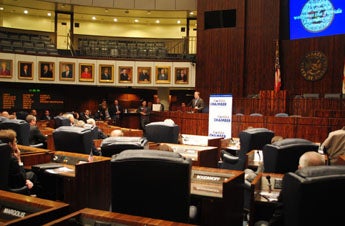As state lawmakers squabble about the budget, UCF economist Sean Snaith warns that cutting corporate and property taxes isn’t the way to draw more businesses and jobs to the Sunshine State.
Florida already has one of the lowest tax burdens in the nation and only lags behind South Dakota, Alaska, Wyoming and Nevada for the best business tax climate in the country, Snaith says in his latest quarterly statewide forecast released this morning.
“There is not much room for improvement as far as the tax climate in Florida is concerned, and trying to be the cheapest date in the country is not going to bolster the number of suitors Florida has,” said Snaith, the director of the University of Central Florida’s Institute for Economic Competitiveness. “There is very little to win in our race to the tax bottom.”
Instead of enacting Gov. Rick Scott’s proposed $1 billion in cuts to corporate income and property taxes, lawmakers should use tax cuts to encourage business behaviors such as providing education and training to employees.
These kinds of incentives would produce a labor force that’s more productive and capable, Snaith adds. “This is a powerful attractant for businesses, and Florida can build a reputation for having a skilled and dynamic workforce, one that the state is investing in and supporting.”
Still, Snaith is more optimistic about Florida’s economic recovery in this report than recent forecasts because of steady gains in Real Gross State Product and personal income.
“This economic growth will slowly help the labor market during its long and difficult path of recovery, and even the construction sector will begin to grow during the next few years,” he added.
Snaith’s forecast offers predictions through 2014 for Florida and its 12 metropolitan regions. Those areas are Naples, Daytona Beach-Deltona, Gainesville, Ocala, Lakeland, Palm Bay-Melbourne, Pensacola, Miami, Jacksonville, Tallahassee, Tampa Bay and Orlando.
His entire report is available online.
Other highlights from his report include:
— Unemployment rates may drift higher as the economy transitions into “job growth mode.” This year should mark the beginning of a long, slow and steady decline in unemployment. But it may be 2018 before we see unemployment fall below 6 percent again.
— Real Gross State Product will expand 2.4 percent this year and then 3.3 percent in 2012, 3.6 percent in 2013 and 4 percent in 2014.
— Florida’s population growth will continue its slow recovery in 2011. By 2014, the growth rate could hit 1.9 percent as the damage from the “Great Recession” is repaired and the Baby Boomer retiree influx starts to swell.
— Housing starts will continue at a painfully slow climb this year. Total starts will be 56.8 annually during the fourth quarter of 2011. By the fourth quarter of 2014, that number will be 168.8 – more than 100,000 fewer starts than at the peak of the housing boom.
Snaith is a national expert in economics, forecasting, market sizing and economic analysis who authors quarterly reports about the state of the economy. Bloomberg News has named Snaith as one of the country’s most accurate forecasters for his predictions about the Federal Reserve’s benchmark interest rate, the Federal Funds rate.
Snaith is also a member of several national forecasting panels, including The Wall Street Journal Economic Forecasting Survey, CNNMoney.com’s survey of leading economists, the Associated Press Economy Survey, the National Association of Business Economics Quarterly Outlook Survey Panel, the Federal Reserve Bank of Philadelphia’s Survey of Professional Forecasters, Bloomberg U.S. Economic Indicator Survey and USA Today Economic Survey Panel.
The UCF Institute for Economic Competitiveness’ mission is to expand public understanding of the economy by convening business leaders, scholars, policy makers, civic groups and media to discuss critical issues.
